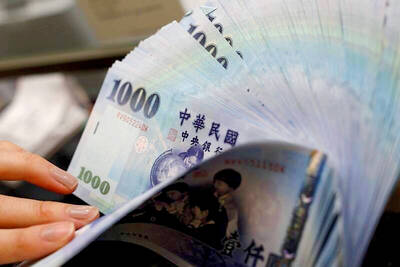Taiwan remained the world’s No. 16 merchandise exporter last year, but showed slower growth in commercial services exports, a report released yesterday by the WTO said, raising concern among local analysts about the strength of Taiwan’s services industry.
The data was listed in an annual global statistics report issued by the Geneva-based WTO, titled World Trade 2007, Prospects for 2008.
Taiwan’s merchandise exports last year reached US$246 billion, capping a 10 percent annual growth and earning it the No. 16 spot in the world, while imports rose to US$220 billion with 8 percent growth year-on-year, maintaining its No. 17 spot from the previous year.
The nation’s total trade value, at US$464 billion, placed Taiwan No. 17 in trading power globally, behind its major competitors in the three newly industrialized economies of South Korea, Hong Kong and Singapore, which ranked No. 11, No. 13 and No. 14 respectively.
LACKLUSTER
Taiwan’s commercial services exports remained at No. 16, with a value of US$30 billion, but with a lackluster 5 percent growth, Taiwan was outperformed by Hong Kong, Singapore and South Korea, which registered annual growth of 13 percent, 13 percent and 28 percent respectively and ranked No. 12, No. 14 and No. 15.
“Somewhat weak export and import growth in dollar terms was reported for Japan and Chinese Taipei (Taiwan) [sic], while growth remained moderate for Hong Kong and Singapore,” the report said.
TOURISM
Specialists on Taiwan warned about the weakness in its commercial service export, saying that the local industries had largely failed to develop export capacity in major service sectors such as tourism, finances and transportation.
“The small growth in the number of inbound tourists is probably the biggest problem in the commercial service sector,” said Cheng Cheng-mount (鄭貞茂), chief economist at Citibank Taiwan, adding that regulations limiting the number of Chinese tourists allowed to visit Taiwan was one of the major obstacles.
He said opening Taiwan to more Chinese tourists, which was part of the president-elect Ma Ying-jeou’s (馬英九) campaign platform, could help improve the situation.
“Three thousand or more [Chinese] tourists per day could boost both the country’s GDP and local market demand, which in turn would spur more business and investment,” he said.
SERVICES
Turning to financial service exports, Cheng said local banks should provide foreign tourists and businesses with more services, such as direct fund transfer and currency exchange, a reference to the restrictions on such exchanges with China — the biggest foreign capital magnet in Asia.
“With a more open policy toward China [by the incoming administration], local banks could locate business and service destinations in China to take advantage of those opportunities,” he said, adding that Taiwanese would also rely less on foreign financial institutions for banking businesses.
Cheng said regulations should also be relaxed to boost the transportation sector, which he said was nevertheless more competitive than the tourism and financial service industries.
“Taiwanese shipping companies sometimes register their vessels under foreign flags to gain access to business in China, as there are strict bans on cross-Taiwan Strait trading and shipping,” he said
Cheng said that because of the under-the-radar nature of those activities, the income made by such companies could not be included in Taiwan’s export performance.
DROPS
The WTO report said that because of a sharp economic deceleration in key advanced economies, world trade growth last year had dropped to 5.5 percent from 8.5 percent in 2006, adding that it would likely decline further to 4.5 percent this year.
The continuing strong growth in emerging economies such as China and India, which increased their merchandise exports by 26 percent and 20 percent respectively, could only partly offset the decline, the report said.

Merida Industry Co (美利達) has seen signs of recovery in the US and European markets this year, as customers are gradually depleting their inventories, the bicycle maker told shareholders yesterday. Given robust growth in new orders at its Taiwanese factory, coupled with its subsidiaries’ improving performance, Merida said it remains confident about the bicycle market’s prospects and expects steady growth in its core business this year. CAUTION ON CHINA However, the company must handle the Chinese market with great caution, as sales of road bikes there have declined significantly, affecting its revenue and profitability, Merida said in a statement, adding that it would

MARKET LEADERSHIP: Investors are flocking to Nvidia, drawn by the company’s long-term fundamntals, dominant position in the AI sector, and pricing and margin power Two years after Nvidia Corp made history by becoming the first chipmaker to achieve a US$1 trillion market capitalization, an even more remarkable milestone is within its grasp: becoming the first company to reach US$4 trillion. After the emergence of China’s DeepSeek (深度求索) sent the stock plunging earlier this year and stoked concerns that outlays on artificial intelligence (AI) infrastructure were set to slow, Nvidia shares have rallied back to a record. The company’s biggest customers remain full steam ahead on spending, much of which is flowing to its computing systems. Microsoft Corp, Meta Platforms Inc, Amazon.com Inc and Alphabet Inc are

RISING: Strong exports, and life insurance companies’ efforts to manage currency risks indicates the NT dollar would eventually pass the 29 level, an expert said The New Taiwan dollar yesterday rallied to its strongest in three years amid inflows to the nation’s stock market and broad-based weakness in the US dollar. Exporter sales of the US currency and a repatriation of funds from local asset managers also played a role, said two traders, who asked not to be identified as they were not authorized to speak publicly. State-owned banks were seen buying the greenback yesterday, but only at a moderate scale, the traders said. The local currency gained 0.77 percent, outperforming almost all of its Asian peers, to close at NT$29.165 per US dollar in Taipei trading yesterday. The

The US overtaking China as Taiwan’s top export destination could boost industrial development and wage growth, given the US is a high-income economy, an economist said yesterday. However, Taiwan still needs to diversify its export markets due to the unpredictability of US President Donald Trump’s administration, said Chiou Jiunn-rong (邱俊榮), an economics professor at National Central University. Taiwan’s exports soared to a record US$51.74 billion last month, driven by strong demand for artificial intelligence (AI) products and continued orders, with information and communication technology (ICT) and audio/video products leading all sectors. The US reclaimed its position as Taiwan’s top export market, accounting for